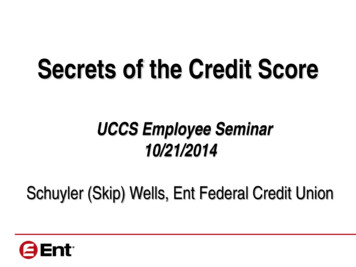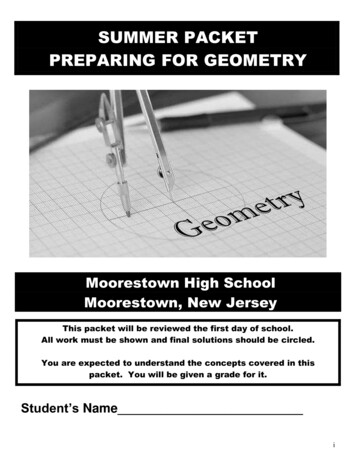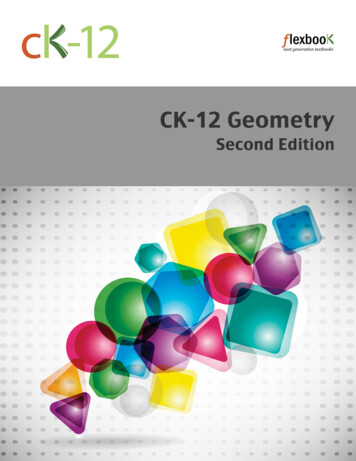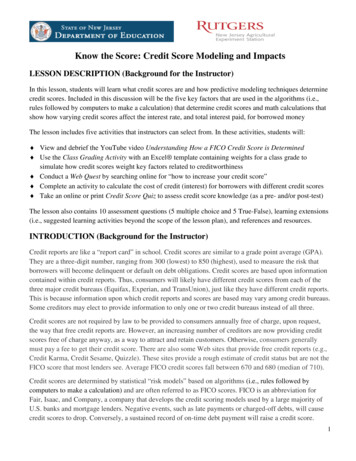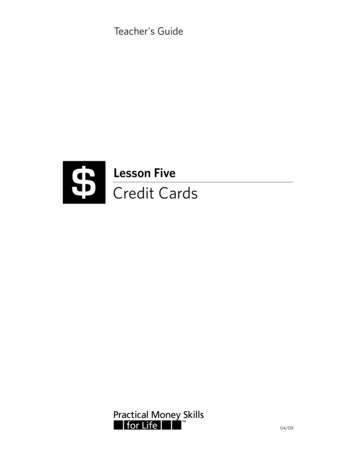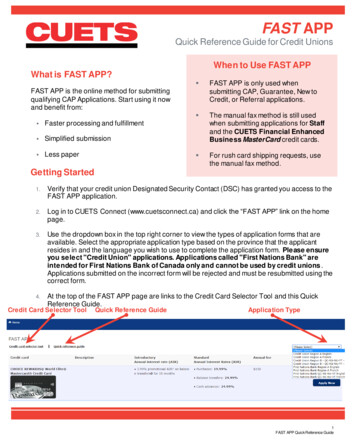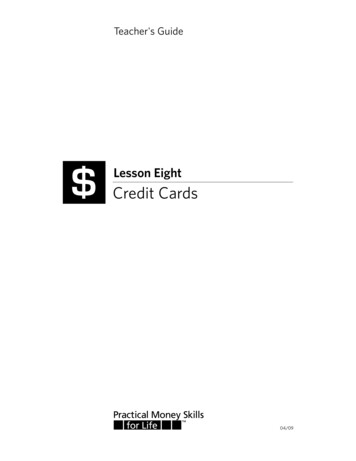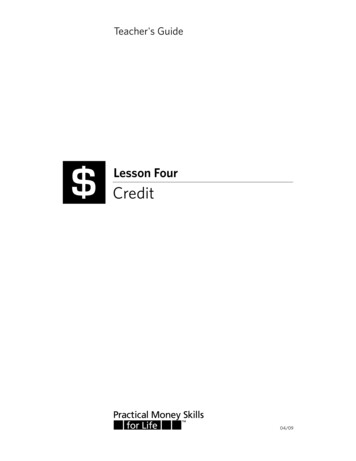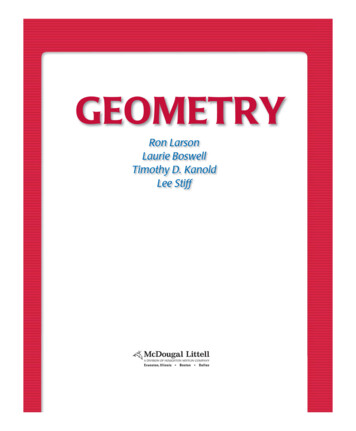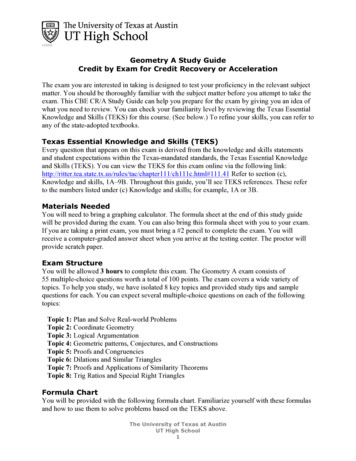
Transcription
121015Geometry A Study GuideCredit by Exam for Credit Recovery or AccelerationThe exam you are interested in taking is designed to test your proficiency in the relevant subjectmatter. You should be thoroughly familiar with the subject matter before you attempt to take theexam. This CBE CR/A Study Guide can help you prepare for the exam by giving you an idea ofwhat you need to review. You can check your familiarity level by reviewing the Texas EssentialKnowledge and Skills (TEKS) for this course. (See below.) To refine your skills, you can refer toany of the state-adopted textbooks.Texas Essential Knowledge and Skills (TEKS)Every question that appears on this exam is derived from the knowledge and skills statementsand student expectations within the Texas-mandated standards, the Texas Essential Knowledgeand Skills (TEKS). You can view the TEKS for this exam online via the following er111/ch111c.html#111.41 Refer to section (c),Knowledge and skills, 1A–9B. Throughout this guide, you’ll see TEKS references. These referto the numbers listed under (c) Knowledge and skills; for example, 1A or 3B.Materials NeededYou will need to bring a graphing calculator. The formula sheet at the end of this study guidewill be provided during the exam. You can also bring this formula sheet with you to your exam.If you are taking a print exam, you must bring a #2 pencil to complete the exam. You willreceive a computer-graded answer sheet when you arrive at the testing center. The proctor willprovide scratch paper.Exam StructureYou will be allowed 3 hours to complete this exam. The Geometry A exam consists of55 multiple-choice questions worth a total of 100 points. The exam covers a wide variety oftopics. To help you study, we have isolated 8 key topics and provided study tips and samplequestions for each. You can expect several multiple-choice questions on each of the followingtopics:Topic 1: Plan and Solve Real-world ProblemsTopic 2: Coordinate GeometryTopic 3: Logical ArgumentationTopic 4: Geometric patterns, Conjectures, and ConstructionsTopic 5: Proofs and CongruenciesTopic 6: Dilations and Similar TrianglesTopic 7: Proofs and Applications of Similarity TheoremsTopic 8: Trig Ratios and Special Right TrianglesFormula ChartYou will be provided with the following formula chart. Familiarize yourself with these formulasand how to use them to solve problems based on the TEKS above.The University of Texas at AustinUT High School1
GEO A 35535 & 45535CBE CR/AStudy GuideScholastic HonestyWhen you arrive at the testing center you will be asked to carefully read the exam rules and signa statement agreeing to take the exam in accordance with the rules. This is called the Examinee’sCertification. The following is a copy of these rules:Examinee’s CertificationThis certification must be signed before the exam is administered and then returned withthe completed examination attached, or credit for the exam will not be given.Scholastic dishonesty is a serious academic violation that will not be tolerated. Scholasticdishonesty encompasses, but is not limited to: copying from another student’s work; using an unauthorized testing proctor or taking the exam at an unauthorized testinglocation; using materials not authorized by a testing proctor; possessing materials that are not authorized by a testing proctor, such as lessons, books, ornotes; knowingly using or soliciting, in whole or Topic, the contents of an unadministered test; collaborating with or seeking aid from another student without authorization during thetest; substituting for another person, or permitting another person to substitute for oneself, intaking a course test or completing any course-related assignment; using, buying, stealing, or transporting some or all of the contents of an unadministeredtest, test rubric, homework answer, or computer program.Evidence of scholastic dishonesty will result in a grade of F on the examination and an F inthe course (if applicable).At the testing center, you will be asked to sign a statement that saysyou have read the above and agree to complete the examination with scholastic honesty.General Study TipsThe bulleted lists and sample questions in this study guide can assist you in preparing for theexam. It is a fairly complete guide for studying, but does not cover every item on the test.Ultimately, you should use the TEKS to guide your exam preparation.Additional Study TipsThe following information provides direction for your studies. For each part, you will find studytips and sample questions to give you a general idea of the types of questions you can expect tosee on the exam.The University of Texas at AustinUT High School2
GEO A 35535 & 45535CBE CR/AStudy GuideTopic 1: Plan and Solve Real-world ProblemsThis is a broad topic that can relate to any type of question. Students should show the ability tocreate a plan for problem-solving, explain their reasoning, and solve problems arising ineveryday life.Study Tips for Topic 1:This topic relates to TEKS 1A–1G. Familiarize yourself with those TEKS, and then be preparedto demonstrate knowledge of the following topics: Solve word problems about the workplace and every day interactions in society Justify your solution to a problem Explain if a solution is or is not reasonable Create and use tables, graphs, number lines, Venn Diagrams and other representations toorganize informationSample Questions for Topic 1:The following are sample questions. You can find the correct answers listed after the questions,but try answering the questions without looking at the answers first to check yourcomprehension.DIRECTIONS: Select the BEST responses to the following questions.1. Derek plans to hang a shelf in his attic. The walls are sloped and meet at the peak pointA, as shown in the figure below where wall AB is 7 feet long and wall AC is 9 feet long.A hole for shelf DE is drilled on wall AB 4 feet up the wall so that BD 4. Since Derekwants the shelf to be parallel to floor BC, where should he drill hole E?A.B.C.D.3.11 feet up the wall from C.3.86 feet up the wall from C.5.14 feet up the wall from C.5.75 feet up the wall from C.The University of Texas at AustinUT High School3
GEO A 35535 & 45535CBE CR/AStudy GuideTopic 2: Coordinate GeometryThis topic relates to your understanding of how to use the Cartesian coordinate system to solveproblems. You will need to be familiar with how to use certain formulas, given on the formulachart, such as midpoint, distance, and slope.Study Tips for Topic 2:This topic relates to TEKS 2A–2C. Familiarize yourself with those TEKS, and then be preparedto demonstrate knowledge of the following topics: Determine the length of a line segment on a number line and on a coordinate plane Describe the connection between the distance formula and the Pythagorean Thoerem Use the slope formula and the midpoint formula to solve real world problems Describe how to derive the formulas for midpoint, distance, and slope Determine whether two lines (or line segments) are parallel, perpendicular, or neither bycomparing their slopes Determine an equation of a line that passes through a given point and is parallel or isperpendicular to a given lineSample Questions for Topic 2:The following are sample questions. You can find the correct answers listed after the questions,but try answering the questions without looking at the answers first to check yourcomprehension.DIRECTIONS: Select the BEST responses to the following questions.2. Given DEF with D(3, 4), E(1, 2), and F(5, 0), find the equation that contains theperpendicular bisector of EF .A.B.C.D.y x–2y 2x – 5y 3x – 8y –x 2.5The University of Texas at AustinUT High School4
GEO A 35535 & 45535CBE CR/AStudy GuideTopic 3: Logical ArgumentationThis topic relates to your understanding of how to use the vocabulary for logical argumentationas well as how to use deductive reasoning to verify or contradict conjectures and statements.Study Tips for Topic 3:This topic relates to TEKS 4A–4D. Familiarize yourself with those TEKS, and then be preparedto demonstrate knowledge of the following topics: Compare, contrast, and give examples of postulates, conjectures, theorems, undefinedterms, and definitions When given a conditional “if-then” statement, identify the converse, inverse, andcontrapositive of the conditional Determine whether the statements are true or false. For example, if a given conditionalstatement is true, would the converse also be true? Is that always the case? Identify biconditional statements and express the connection they have to a statement andits converse Use a counterexample to prove a conjecture is false Familiarize yourself with the basic meanings of Euclidean geometries and sphericalgeometries, specifically with the definitions of parallel lines and of triangle angle sums inboth types of geometriesSample Questions for Topic 3:The following are sample questions. You can find the correct answers listed after the questions,but try answering the questions without looking at the answers first to check yourcomprehension.DIRECTIONS: Select the BEST responses to the following questions.3. Assume the conditional statement below is true. Then answer the question that follows.Conditional Statement: If something is a blip, then it is also a blop.Given that the above conditional statement is true, which of these must be true?A.B.C.D.the inversethe conversethe contrapositivenone of these is trueThe University of Texas at AustinUT High School5
GEO A 35535 & 45535CBE CR/AStudy Guide4. A bearded old man with flying reindeer flies in a triangular pattern starting at the NorthPole, then directly south to City A on the equator, then straight West to City B which isalso on the equator, and lastly straight North back to the North Pole where he can finallyget some rest.Given that the shape of the Earth can be approximated by spherical geometries, which ofthese is a possible sum of the 3 angles formed by this triangle?A.B.C.D.85 95 175 185 Topic 4: Geometric patterns, Conjectures, and ConstructionsThis topic relates to your understanding of how geometric objects are constructed using acompass and straight edge as well as how to make and test conjectures about geometricproperties.Study Tips for Topic 4:This topic relates to TEKS 5A–5D. Familiarize yourself with those TEKS, and then be preparedto demonstrate knowledge of the following topics: Make conjectures about angles formed by parallel lines intersected by transversals,triangle congruence criteria, diagonals, interior and exterior angles of polygons, andspecial segments and angles of circles Identify, explain, and problem solve using constructions of congruent segments, segmentbisector, angle bisector, perpendicular lines, perpendicular bisector, and parallel linesthrough a given point State and use the triangle inequality theorem Use the triangle inequality theorem to solve problemsSample Questions for Topic 4:The following are sample questions. You can find the correct answers listed after the questions,but try answering the questions without looking at the answers first to check yourcomprehension.The University of Texas at AustinUT High School6
GEO A 35535 & 45535CBE CR/AStudy GuideDIRECTIONS: Select the BEST responses to the following questions.5. Solve for x in the diagram.A.B.C.D.15 18 21 24 6. Which of the images below illustrates a construction of an angle bisector?I.A.B.C.D.II.III.I onlyII onlyII and IIII, II, and IIIThe University of Texas at AustinUT High School7
GEO A 35535 & 45535CBE CR/AStudy GuideTopic 5: Proofs and CongruenciesThis topic relates to your understanding of how to verify and use theorems about angles,segments and triangles. This topic includes properties and proofs of congruent triangles.Study Tips for Topic 5:This topic relates to TEKS 6A–6E. Familiarize yourself with those TEKS, and then be preparedto demonstrate knowledge of the following topics: Identify, verify, and use properties of intersecting lines and segments to solve problems.For example, you will be asked about vertical angles, parallel lines cut by a transversal,and the distance between the endpoints of a segment and a given point on itsperpendicular bisector Complete proofs about triangle congruence. You should be able to identify steps andjustifications for each step in a 2-column proof Use SAS, ASA, SSS, AAS, and HL to prove triangles are congruent Identify corresponding parts of congruent triangles Verify theorems about the relationships in triangles. For example, you will be askedabout proofs of the Pythagorean Theorem, triangle angle sums, base angles of isoscelestriangles, midsegments and medians and you should be able to recognize when you needto use one of these properties to solve a problem Prove whether or not a quadrilateral is a parallelogram, a rectangle, a square, or arhombusSample Questions for Topic 5:The following are sample questions. You can find the correct answers listed after the questions,but try answering the questions without looking at the answers first to check yourcomprehension.DIRECTIONS: Select the BEST responses to the following questions.7. You are trying to prove that the two triangles below are congruent. Which of thefollowing properties is LEAST useful?A.B.C.D.Vertical AnglesAngle-Side-AngleAngle-Angle-SidePythagorean TheoremThe University of Texas at AustinUT High School8
GEO A 35535 & 45535CBE CR/AStudy GuideTopic 6: Dilations and Similar TrianglesThis topic relates to your understanding of identifying similar figures and using them to solveproblems.Study Tips for Topic 6:This topic relates to TEKS 7A and 7B. Familiarize yourself with those TEKS, and then beprepared to demonstrate knowledge of the following topics: Use dilations to identify similar figures and their congruent angles Write proportions given two similar figures and use them to solve problems Apply the Angle-Angle criterion for similar triangles to solve problemsSample Questions for Topic 6:The following are sample questions. You can find the correct answers listed after the questions,but try answering the questions without looking at the answers first to check yourcomprehension.DIRECTIONS: Select the BEST responses to the following questions.8. ΔOLD below needs to be enlarged by a scale factor of 4 so that ΔOLD ΔNEW. Whichof these best describes the resulting ΔNEW ?A.B.C.D.EW 6, m N 72 EW 6, m N 18 NE 16, m W 72 NE 16, m W 108 The University of Texas at AustinUT High School9
GEO A 35535 & 45535CBE CR/AStudy GuideTopic 7: Proofs and Applications of Similarity TheoremsThis topic relates to your understanding of using deductive reasoning to prove theorems abouttriangles. You will be expected to complete two-column proofs.Study Tips for Topic 7:This topic relates to TEKS 8A and 8B. Familiarize yourself with those TEKS, and then beprepared to demonstrate knowledge of the following topics: Understand and use the triangle proportionality theorem to solve problems Prove theorems about triangles Given a right triangle and an altitude drawn to its hypotenuse, identify the similartriangles created Given a right triangle and an altitude drawn to its hypotenuse, use the concept ofgeometric mean and write proportions to solve problemsSample Questions for Topic 7:The following are sample questions. You can find the correct answers listed after the questions,but try answering the questions without looking at the answers first to check yourcomprehension.DIRECTIONS: Select the BEST responses to the following questions.9. Determine the approximate length of the altitude, h. Round your answer to the nearesthundredth.A.B.C.D.12.013.215.018.4The University of Texas at AustinUT High School10
GEO A 35535 & 45535CBE CR/AStudy GuideTopic 8: Trig Ratios and Special Right TrianglesThis topic relates to your understanding using trigonometric ratios and special right triangles todetermine missing side lengths and angles of right triangles.Study Tips for Topic 8:This topic relates to TEKS 9A and 9B. Familiarize yourself with those TEKS, and then beprepared to demonstrate knowledge of the following topics: Familiarize yourself with the right triangle formulas on the formula chart and before testday, be sure to know how to use each of them to solve problems Use sine, cosine, and tangent ratios to write equations and solve problems Use Pythagorean theorem and recognize common sets of Pythagorean Triples and theirmultiples (e.g. 5-12-13 and 10-24-26) Apply the relationships given in the formula chart for special 30-60-90 and 45-45-90right triangles to solve problemsSample Questions for Topic 8:The following are sample questions. You can find the correct answers listed after the questions,but try answering the questions without looking at the answers first to check yourcomprehension.DIRECTIONS: Select the BEST responses to the following questions.10. What is the approximate length of side a?aA.B.C.D.11 m37 6.62 m8.78 m13.77 m18.21 mThe University of Texas at AustinUT High School11
GEO A 35535 & 45535CBE CR/AStudy GuideAnswer KeyItem NumberCorrect Answer12345678910CBCDDCDCACTEKSexpectation1A, 1B, 8A2B, 2C4B4D5A5B6B7A8B9AThe University of Texas at AustinUT High School12
GEO A 35535 & 45535CBE CR/AStudy GuideGeometry Formula SheetCoordinate GeometryDistance Formula: d ( x2 x1 )2 ( y2 y1 )2Slope of a line: m y 2 y1x2 x1 x x2 y1 y2 ,Midpoint Formula: 1 22 Slope-Intercept Form of an Equation: y mx bStandard Form of a Linear Equation:Ax By CPoint-Slope Form of an Equation:y y1 m ( x x1 )Perimeter and CircumferencePerimeter of a rectangle:P 2l 2w or P 2(l w)AreaCircumference: C 2πr or C πdPrism:Rectangle or Parallelogram: A bh1aP21A bh21A (b1 b2 )h2A Regular Polygon:Triangle:Trapezoid:Circle:A πr2Rhombus:1A d1 d 22Cylinder:Pyramid:4 3πr31Pl21Pl B2Cone:Lateral SA πrlTotal SA π rl π r 2Sphere:Total SA 4π r 2Right TrianglesPrism or cylinder: V BhSphere: V Lateral SA Total SA VolumePyramid or cone: V Surface AreaLateral SA PhTotal SA Ph 2 BLateral SA 2πrhTotal SA 2π rh 2π r 21Bh3opposite sidehypotenuseadjacent sidecos( B) hypotenusesin( B) tan( B) opposite sideadjacent sidePythagorean Theorem:a2 b2 c2The University of Texas at AustinUT High School13
UT High School 4 Topic 2: Coordinate Geometry This topic relates to your understanding of how to use the Cartesian coordinate system to solve problems. You will need to be familiar with how to use certain formulas, given on the formula chart, such as midpoint, distance, and slope.

